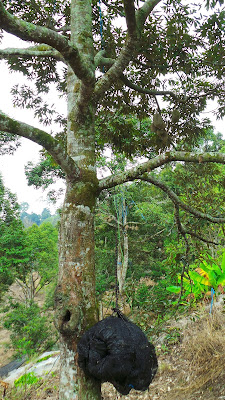| Two of three MSW durians which the Master opened for us to try. One of the fruits is from a 3-year grafted tree and it tasted very nice. According to Keung, MSW is better value for money than say Black Thorn bec the flesh-to-weight ratio is 30-35% for MSW vs 20-25% for Black Thorn, which is very pricey these days. It may surprise you that in a year, the plantation may have 4-6 seasons bec of the care and attention given to the trees, like fertilisation and watering in dry periods. MSW are classified into Cats A, B and C, by size, weight and shape. Cat A durians are the big and well-shaped ones and these are usually exported. Cat B ones are mostly sold in Malaysia. Those classified C are the smaller and odd-shaped ones. The taste? What is your take? |

















No comments:
Post a Comment